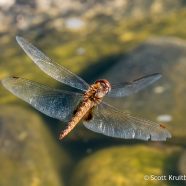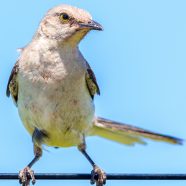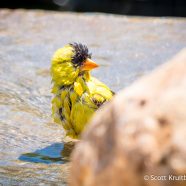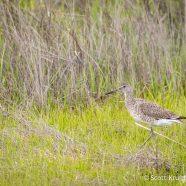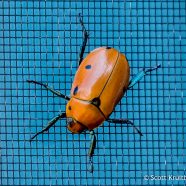Spot-winged Glider
I finally captured a Spot-winged Glider (Pantala hymenaea) on the wing, and in this case it while the dragonfly was ovipositing – laying eggs in this pool. You can clearly see the basal spots on the inside of the hindwings along with some wear. Flying around the world must get a bit tiring… Scott Kruitbosch Conservation & Outreach Coordinator
Read MoreMockingbird Parent
The Northern Mockingbird (Mimus polyglottos) seen here was as ferocious as a dinosa — er, bird, can get. Well, maybe not in the literal sense, but did you ever have the feeling that something was out to get you? This bird felt like giving me a tap or two in the head, something Mockingbirds did to me as a child on multiple occasions while on our patio near a nest in a bush. It turns out that the nasty look I was receiving here was for a similar reason as there were fledglings nearby. This Mockingbird refused to fly away as I walked up the roadway within several feet and stared me down...
Read MoreAmerican Goldfinch Bath
It must feel splendid to take a warm bath in the summertime as opposed to trying to clean the feathers in the ice and snow all winter long. Go you, American Goldfinch (Spinus tristis)! Soak it up!
Read MoreAugust Sunset
The summer sunset at Stratford Point can still be wonderfully reflected in our surroundings even without a cloud in the sky thanks to all of our Queen Anne’s Lace.
Read MoreWillet
Here is a Willet (Tringa semipalmata) that I photographed during the Noble Proctor BioBlitz Challenge this past May. Now that we have entered August we are firmly in the time of year for these birds to be found as migrants in many marshes, wetlands, beaches and coastal locations. We can also expect to find one or two Western Willets that have a distinctly different appearance including a softer toned, less-barred gray body, a slightly leaner bill, and a bit of a larger overall size. See if you can spot one soon! That can be a difficult task to begin with as you can see how well their...
Read MoreGrapevine Borer Beetle
This seems to be a Grapevine Borer Beetle (Pelidnota punctata) as I found and photographed on this door screen last week. Their common name betrays their preferred plant and behavior, eating the fruit and even the leaves of grapevines, though apparently not to extreme pest levels. I was also not the only one to think about how it looks like a huge ladybug in some ways. You never know what new sorts of neighbors you will find even at your own door… Scott Kruitbosch Conservation & Outreach Coordinator
Read More



